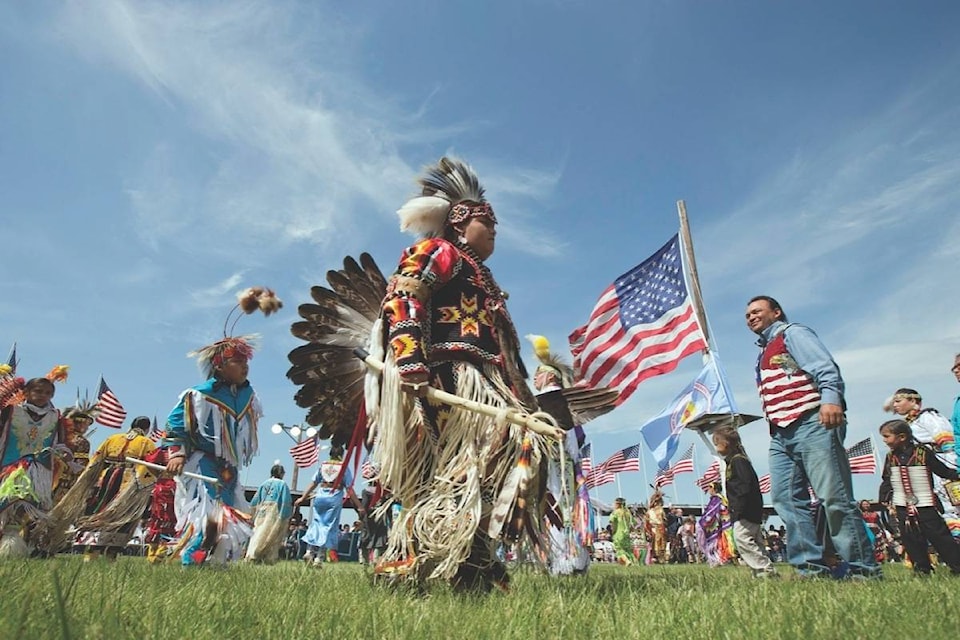SOAP LAKE — When the people dance, they stay connected: One earth, one Mother, moving to the heartbeat of the drum.
It’s a time-honored way to honor culture, remember relatives, pay respect to the elders and remember the importance of the land. Smokiam Park came alive this past weekend with the fifth annual Soap Lake Powwow. The days and nights erupted with dance and drum, smiles and laughter like an age-old gathering of old times, blending culture from past and present on the ancestral lands of the Tsincayuse (the Chief Moses people).
The powwow dates back to 1953 and was held annually until 1972. As time moved forward into the 21st century, members of the Colville Nation formed the Soap Lake Powwow Association Inc. as a non-profit to share their Native American traditions, history and rejuvenate the powwow on the shores of the Smokiam (the healing waters).
Fifty dancers and seven drum groups and their families traveled from far and wide to participate, some from as far away as Browning, Mont. Last year marked the return of the horse parade after a 45-year absence. It was good times again, the people danced and Indians and non-Indians alike enjoyed the stories, the cultural exchange, keeping the native ways moving forward just like they did prior to the 20th century when changing times threatened to wipe out the American indigenous peoples.
Prior to the coming of the Europeans, individual nations practiced their individual dances, cultures and customs on their own homelands. But with the coming of the reservation system, it all changed and the only way Native people could carry on age-old dance and customs was to join forces.
It is said the word powwow comes from an Algonquian word pau wau, meaning, “he dreams.”
The people have kept the dream alive since creation. There is no exact record, but the powwow was thought to have begun with the Pawnee Nation as a religious ceremony filled with personal, reverent, and religious significance.
It is said, the modern day powwow evolved from the Grass Dance Societies that formed during the early 1800s. With the coming of the reservation system, the people were forced to adapt without sacrificing meaning. There was a time when tribal customs and religious ceremonies were outlawed by the government, but the Grass Dance was one of the few celebrations allowed. It became a way to maintain tribal customs that were slowly vanishing.
Many of the Plains tribes formed alliances. The songs, dances, and ceremonies by each nation were exchanged, laying the groundwork for the “intertribal powwow.”
What began as a ceremony giving thanks for a successful hunt/harvest or preparation for upcoming battle or reenactment of a brave deed, moved forward with the same sense of cultural and personal pride. One-time enemies or cultures not known to each other began to come together as one.
About 67 tribes have been historically associated with the modern-day state of Oklahoma. It is said, the first intertribal powwow in Oklahoma was the Ponca Powwow in northern Indian Territory around 1879.
The tribes united. They traveled from as far away as 100 miles by horseback to dance, to sing to remember the old ways and bring them into a new and confusing time.
They put aside their cultural and tribal differences and came together as one. Despite the forced changes crashing down all around them, the events inspired cultural and personal pride in American Indians. It allowed the tribes, families, and individuals to come together for feasting, to hear their languages spoken, to sing and dance. The people upheld tribal customs with dignity and honor.
Since the beginning, it was passed down from generation to generation that men did most of the dancing. But over time, women have taken their place in the sacred circle.
The dance steps are as ancient and timeless. Some imitate an animal’s gait and behavior. Others, like the Grass Dance, mimic the wind blowing through the buffalo grass so prevalent on the plains. Each step has purpose. Each step honors the Creator’s work.
There are several styles of dance used in competition: men’s and women’s Traditional; men’s Fancy Dance and Women’s Fancy Shawl, the Grass Dance (men only), and the Jingle Dress Dance (women only).
As it is with prayer, there is no one way to honor the Creator. There is no one way to dance in the traditional manner. Tribal affiliation, personal preference and spiritual values come out through the steps of each individual dancer.
In the men’s Traditional, the dancer moves his foot forward, tapping it twice. As his foot presses forward, the first tap is lighter as he shifts his weight forward on the second step. It is said, the motion honors the animals with the imitation of their stride: two human motions per leg give honor to the four-leggeds.
The men’s Traditional dancers are the protectors and preservers of the traditional ways; with their double eagle feather bustles and their high kicking steps. Each man tells a particular story through his motions.
As they dance, the steps taught to them by their fathers or grandfathers, are deliberate, telling the story of the hunt or an act of courage. Done properly, the audience can interpret and follow along with the movement of each storyteller.
Women’s Traditional involves a slow-moving or non-moving bouncing step, rhythmically swaying to the beat of the drum. Their dresses are made of buckskin, wool or other material decorated with bead and quill-work. Dancers might include shells, teeth or antler decorations. The colors are subtle, more intoned with Father Sky or Mother Earth.
The modern-day powwow is a connection to a time when the only man-made footprints on the land were made by moccasins.
